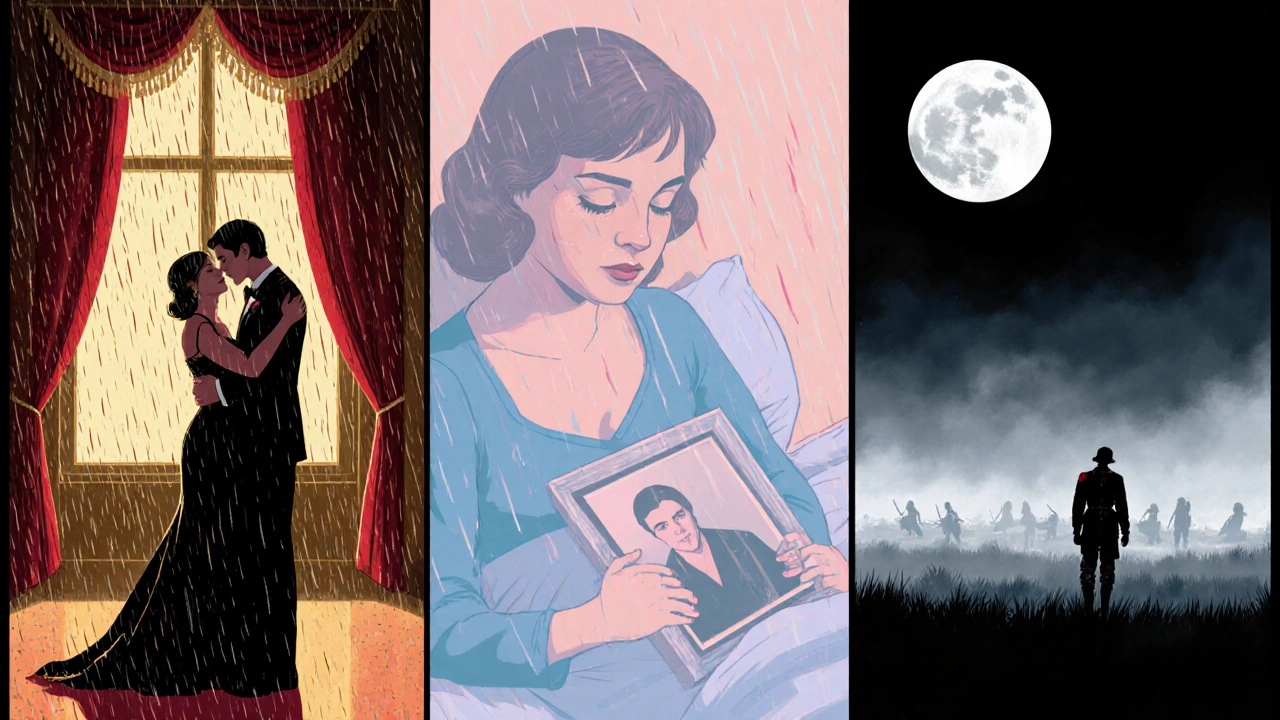Ever wondered what you’re actually watching when a film leaves you reaching for the tissues? The term sad movie genre isn’t a single label you’ll find on a streaming menu, but there are a handful of well‑defined categories that specialize in pulling at heartstrings. In this guide we’ll sort out the main genres, point out their hallmark traits, and give you a quick way to spot the next tear‑jerker before you press play.
Key Takeaways
- Sad movies are primarily grouped under Melodrama, Tearjerker, and classic Drama.
- Each sub‑genre leans on different emotional triggers: moral dilemmas, doomed romance, or personal tragedy.
- Typical plot elements include loss, sacrifice, illness, or coming‑of‑age hardships.
- Notable examples span from The Notebook (romantic melodrama) to Schindler’s List (historical tragedy).
- A quick checklist-tone, themes, character arcs-helps you label a film on the spot.
What Makes a Movie “Sad”?
A sad film isn’t just one that happens to have a bleak ending. It’s built around an emotional core that repeatedly nudges the audience toward empathy, grief, or catharsis. Psychologists point out three ingredients that most sad movies share:
- Relatable loss: The protagonist suffers a loss that viewers can imagine in their own lives-death, separation, or a shattered dream.
- Emotional pacing: Scenes are deliberately slowed down, allowing moments of silence or mournful music to settle.
- Hope or redemption: Even the darkest stories often hint at an uplift, which makes the sadness feel purposeful rather than gratuitous.
When these threads are woven together, the result falls into one of several genres that specialize in evoking tears.
Core Genres Associated with Sad Movies
Melodrama
Melodrama is a film genre that emphasizes heightened emotions, moral conflicts, and often a clear divide between good and evil. Its roots trace back to 19th‑century stage plays, and it moved to the silver screen in the early 1900s. Typical hallmarks include:
- Exaggerated circumstances (e.g., a sudden tragic death).
- Clear moral lessons-usually about love, sacrifice, or duty.
- Intense, swelling musical scores that cue the audience’s feelings.
Classic examples are Love Story (1970) and West Side Story (1961). Modern melodramas like Room (2015) keep the formula alive while adding nuanced performances.
Tearjerker
A tearjerker is less a formal genre and more a label for any film whose primary intent is to make viewers cry. The term is often applied to romantic dramas, biopics, or family stories that focus on loss and reconciliation. Core traits include:
- Intimate character studies-often a single protagonist’s emotional journey.
- Frequent use of close‑up shots to capture subtle facial expressions.
- Soundtracks that feature piano, strings, or choral vocals.
Well‑known tearjerkers are The Notebook, Steel Magnolias, and the animated Up (2009), whose opening sequence alone sparked a wave of online memes about its emotional power.
Tragedy
Tragedy is a broader literary category that translates directly into film. While all tragedies are sad, not every sad film qualifies as a tragedy. Tragic films portray a protagonist whose fatal flaw leads to inevitable downfall. Hallmarks include:
- Fatalism-events feel beyond the character’s control.
- Complex moral ambiguity-heroes may be deeply flawed.
- Often set against historical or mythic backdrops.
Iconic tragedies include Schindler’s List, Requiem for a Dream, and the Shakespeare‑adapted Romeo + Juliet (1996).
Specialized Sub‑Genres That Pack a Sad Punch
While melodrama, tearjerker, and tragedy cover most bases, a few niche sub‑genres also excel at delivering melancholy:
- Romantic drama: Focuses on love that cannot survive-think Blue Valentine or Eternal Sunshine of the Spotless Mind.
- Coming‑of‑age drama: Shows youthful loss of innocence, as in Boyhood or The Perks of Being a Wallflower.
- Psychological drama: Delves into mental anguish, with titles like Black Swan and Manchester by the Sea.

Side‑by‑Side Comparison
| Genre | Core Emotion | Typical Plot Elements | Notable Examples |
|---|---|---|---|
| Melodrama | Intense empathy | Loss, moral dilemma, redemption | Love Story, Room, The Notebook |
| Tearjerker | Heart‑ache | Personal tragedy, family bonds, hopeful resolution | Steel Magnolias, Up, A Star Is Born |
| Tragedy | Fatalism | Fatal flaw, unavoidable downfall, moral ambiguity | Schindler’s List, Requiem for a Dream, Romeo + Juliet |
How to Identify a Sad Movie in One Glance
Next time you’re scrolling through a catalog, use this quick checklist to tag a film as a sad‑movie candidate:
- Tagline or synopsis mentions “loss,” “heartbreak,” or “coming of age.”
- Poster colors lean toward muted blues, greys, or sepia.
- Director’s past work includes known melodramas (e.g., John Carney, Greta Gerwig).
- Soundtrack features somber piano or string pieces.
- Cast includes actors famous for emotional performances (e.g., Meryl Streep, Joaquin Phoenix).
Common Confusions & How to Avoid Them
Not every film with a sad moment belongs to a sad genre. Action movies often have tragic deaths, but their primary goal is spectacle, not catharsis. Similarly, horror films can be emotionally devastating, yet they’re classified by fear, not grief. To stay clear:
- Ask yourself whether the film’s main narrative drive is the emotional journey or an external conflict.
- Look for recurring themes of personal sacrifice rather than just a single sad scene.
- Check reviews: Critics usually label a film as “a melodrama” or “a tearjerker” when those elements dominate.
Frequently Asked Questions
Is "sad movie" an official genre?
No. "Sad movie" is a descriptive term. The official genres that produce sadness are Melodrama, Tearjerker, Tragedy, and various drama sub‑genres.
How does a melodrama differ from a regular drama?
Melodrama leans into exaggerated emotions and clear moral stakes, while a standard drama may stay more subtle and ambiguous.
Can a comedy be a tearjerker?
Yes, hybrid films like Little Miss Sunshine blend humor with heartbreaking moments, earning the tearjerker label despite their comedic core.
What are some recent sad movies worth watching?
Look for titles like Nomadland (2020), Portrait of a Lady on Fire (2019), and The Father (2020). All fit within the melodrama/tearjerker spectrum.
How do film festivals treat sad‑movie genres?
Festivals like Cannes and Sundance often spotlight powerful dramas and tragedies in their main competition, as these categories showcase strong storytelling and emotional depth.


Wow, this guide really hits home. I’ve always felt that crying over a movie is just a sign you’re connecting with the story, not that you’re weak. The way you broke down melodrama and tearjerker makes it easier to pick the next film for a good cry.
Honestly, calling melodrama “exaggerated” sounds like a lazy shortcut to avoid analyzing its cultural relevance.
Glad you found it useful! I’d add that looking at the soundtrack can be a quick hint – a lot of strings means they’re gearing you up for an emotional ride.
Just keep an eye on the poster colors too.
The article is solid, but “its” should be “it’s” in the sentence about “its main narrative drive.” Other than that, the structure works.
Good catch! Small errors can distract, but the overall insight still shines – keep exploring those emotional cues.
While the exposition is comprehensive, the excessive use of the term “sad movie genre” borders on tautology, thereby diluting scholarly rigor. Moreover, the absence of citations undermines the authority of the psychological claims presented herein.
Isn’t it weird how every “psychologist” quote just lines up with Hollywood’s profit motives? I bet the industry pushes these so‑called “sad genres” to manipulate audience sentiment and boost ticket sales.
Sad movies occupy a unique moral space in cinema, serving as mirrors that reflect our deepest vulnerabilities. They compel us to confront loss, a universal condition that many prefer to ignore. By dramatizing personal tragedy, these films teach empathy, a virtue that is essential for a compassionate society. When a character endures hardship and persists, viewers internalize that resilience as a guiding principle. The melodramatic excess, often criticized, actually amplifies the emotional stakes, making the moral lesson unmistakable. Tearjerkers, with their intimate focus, strip away superficial distractions, allowing the audience to sit with raw grief. Tragedies, steeped in fatalism, remind us of the consequences of flawed choices, reinforcing ethical responsibility. Moreover, the ritual of crying in a dark theater creates a communal catharsis, bonding strangers through shared sorrow. This collective experience reinforces social cohesion, an often overlooked benefit of sad storytelling. The narrative structures outlined in the guide-loss, pacing, redemption-are not merely formulaic; they are ethical scaffolding. Each plot element serves to shepherd the viewer toward a deeper understanding of human frailty. The inclusion of hope or redemption ensures that sadness does not become nihilism, but a pathway to growth. This also makes sad movies valuable educational tools for discussing morality and empathy. The guided checklist, while practical, also functions as a moral compass for selecting stories that align with these values. By recognizing the genre’s intent, we can appreciate the deliberate craftsmanship behind every tearful scene. Ultimately, sad movies are not just entertainment; they are moral laboratories where we experiment with compassion, sacrifice, and redemption.
The notion that we “experiment with compassion” resonates; perhaps the audience becomes both observer and participant in this ethical trial.
Indeed, the viewer, by virtue of immersion, assumes a dual role-simultaneously a detached analyst, and a visceral empath, thereby blurring the line between spectator and subject, which, in turn, enriches the cinematic discourse.
Think of a sad film as a workout for the heart; the more you push, the stronger your emotional muscles become.
Sure, because everyone wants to spend their weekend doing cardio with a side of heartbreak.
i was watching the latest drama and didnt expect to get so caught up, the music really pulls you in and the story hits just right, i think its a good pick for anyone who wants a good cry.